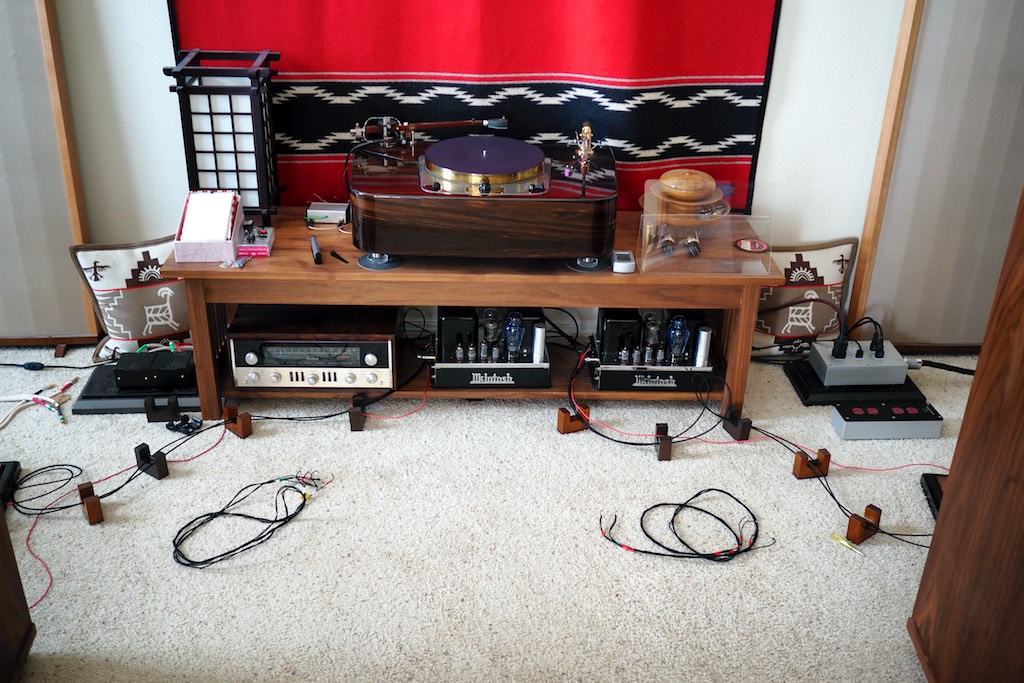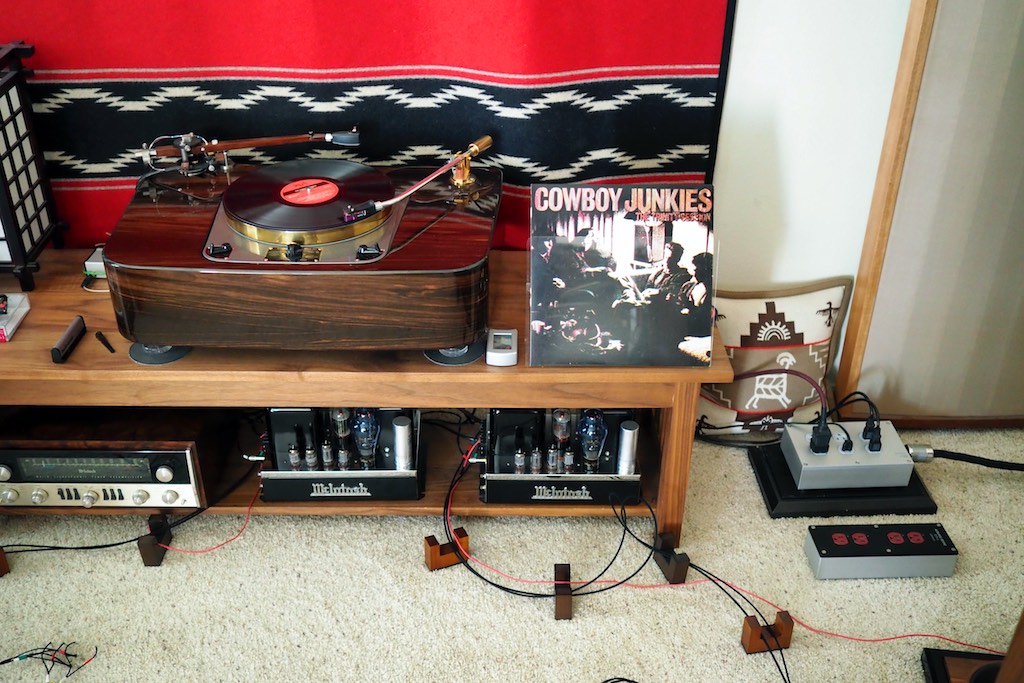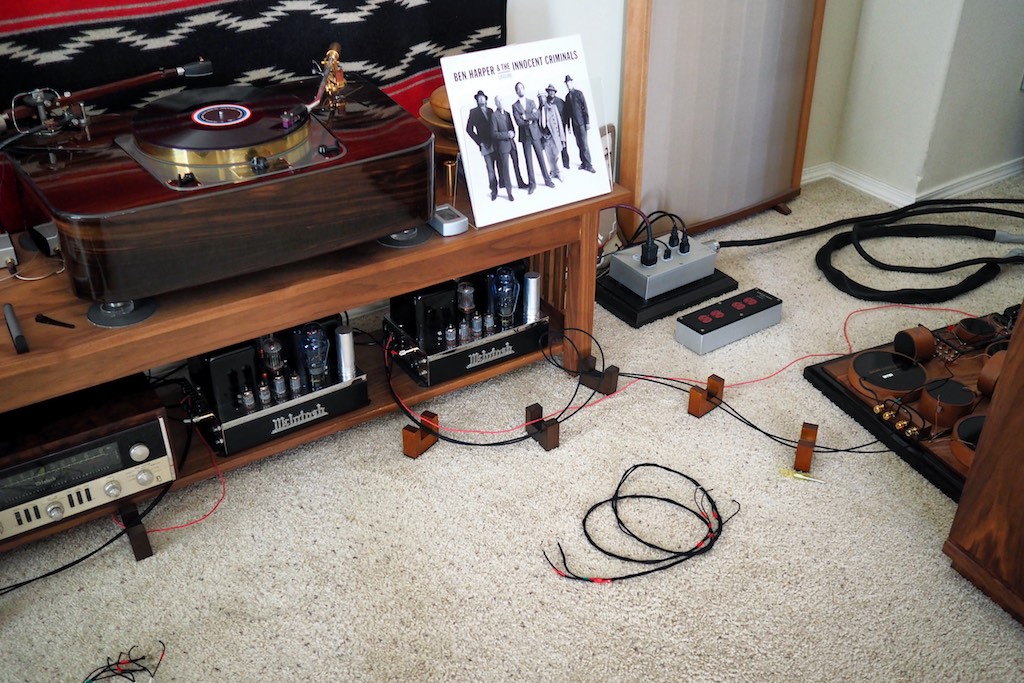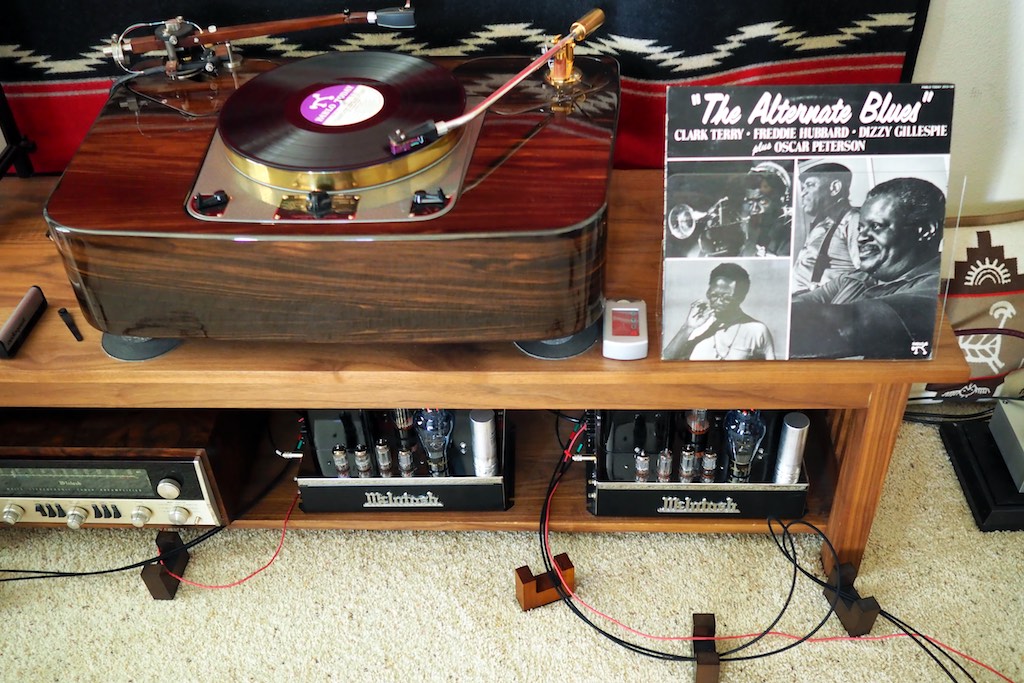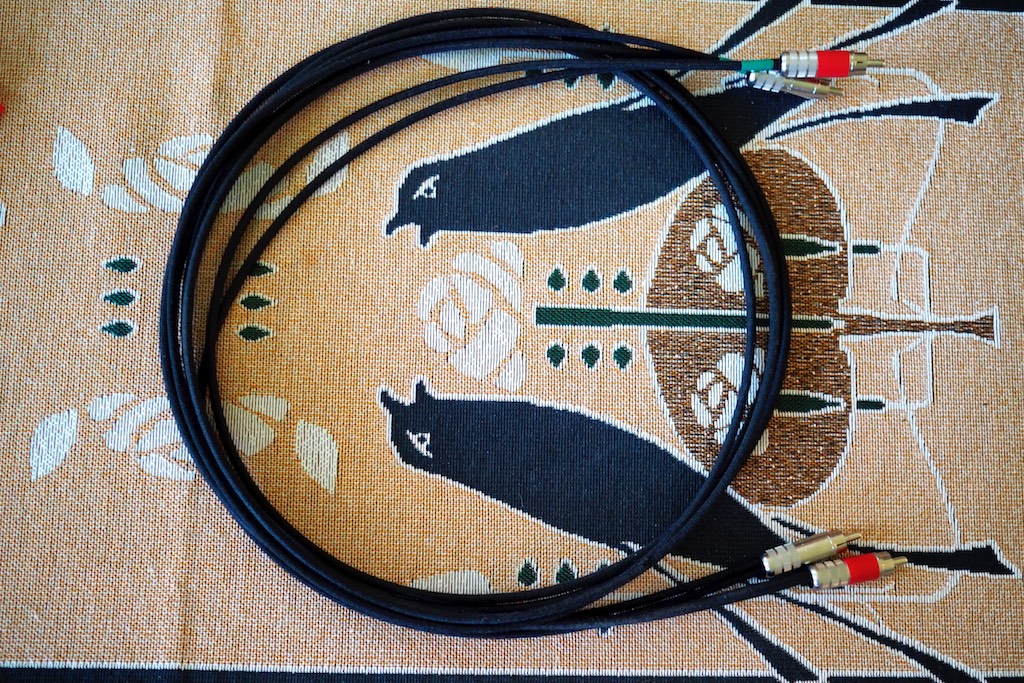Yesterday Leo, Pete, Rahul, and Ron, stopped by for a little hi-fi and music listening fun & games, and Ron was telling me how much he likes the Duelund DCA12GA he has rewired his system with.
That motivated me this morning to cut four six-foot lengths of the DCA12GA to try as a pair of speaker cables, and four six-inch lengths of DCA12GA to use as crossover jumpers on my Duelund CAST crossovers.

Duelund DCA12GA connecting to the LF connections on my Duelund CAST crossovers, with DCA12GA jumpers connecting to the HF connections.
The current internal wiring in my crossovers is DCA20GA for the high-frequency sections and Duelund DCA16GA internal wiring for the low-frequency sections.
In the foreground you can see the bi-wire set of speaker cables made from Duelund DCA16GA for the LF connections, and DCA20GA for the high-frequency connections, that I have been enjoying in my system.
After letting the system warm up for a while, for a first listen I put on the Cowboy Junkies' The Trinity Session.
Ron had told me, that in true-tinned copper fashion, the DCA12GA he rewired his system with sounded good right off the roll, but that it improved considerably over the three weeks he's had it in his system, so I was curious what I would hear from it.
My first impression of the DCA12GA was that there was definitely a familial tinned-copper tonal signature with the DCA16GA and DCA20GA that I had been listening to as speaker cables, with a natural 'real sound' portrayal of tone color, timbral textures, and now famous 'vividness' effect that I enjoy so much about tinned copper conductors.
There's definitely differences in their sound and performance though, and the first difference that I noted was that with the DCA12GA there was a slight 'dryness' to the vocals on The Trinity Session that I haven't noticed with my bi-wired DCA16GA/DCA20GA speaker cables, and that there were occasional instances of stridency as well.
I suspect that the 'dryness' and occasional instances of stridency would disappear with DCA20GA as jumpers to the high-frequency connections, or by using it in a bi-wire arrangement with the DCA12GA, so I'll test that theory in the near future. It also may disappear as the DCA12GA gets some run-in time on it, so I'll report back on that.
The next obvious difference came to light listening to the Ben Harper & The Innocent Criminals Lifeline LP, which is a terrific album, and if you've never heard it you're in for a treat!
I noted with Lifeline that the bass response with the DCA12GA was less prominent, more balanced, and more controlled than with my bi-wire DCA16GA & DCA20GA combination. In comparison, my bi-wire Duelund DCA16GA & DCA20GA combination sounded a more prominent, but a bit overblown in the bass.
Lifeline opens with the song 'Fight Outta You', and it's got a real nice rock & roll backbeat that makes you want to get up and dance around. Although I liked the more balanced bass presentation better with the DCA12GA, I did notice that the DCA12GA lost a little bit in communicating the beat, which decreased the feeling of danceability, which I didn't like as well.
On The Alternate Blues the DCA12GA did a beautiful job of portraying the tonal balance of the horns, sounding very 'real' and natural, and I really like what I was hearing both musically & sonically.
Keep in mind these are very preliminary listening impressions, and I suspect the DCA12GA will transform quite a lot after about 100 hours or so of playing time.
My initial impressions are that the DCA12GA as speaker cables are also warmer & richer sounding than the my usual bi-wire DCA16GA/DA20GA speaker cables, which I also like a lot.
I also think that the sibilance region for horns and voices sounds more natural with the DCA12GA, another plus for me.
Ok, it's way too early to make any detailed observations about the DCA12GA, but it's certainly off to a good start in my system, and I'll provide more observations about it as it traverses the run-in process (or maybe I'll put it on my Cable Cooker to speed the process up).
The good news is that I like what I'm hearing from the DCA12GA a lot, and it has that familiar vividness, beautiful tone color, and timbral 'realness' that I love about tinned-copper conductors, and the nits I have to pick are small, and I suspect they will work themselves out with adequate run-in time on them.
I'd say the DCA12GA is another home run hit for Frederik!
¸¸.•*¨*•♫♪¸¸.•*¨*•♫♪¸¸.•*¨*•♫♪
Update: I couldn't stand it, I just had to try building a pair of interconnects out the Duelund DCA12GA for the preamp to power amps connection in my main music system to see what would happen.
It's a bit of a crazy idea, really, as physically the bundle of conductors in the DCA12GA is too big to fit into the pin receptacle of the Switchcraft RCA's.
The DCA12GA is a big and relatively stiff cable, and RCA connectors are designed to be used with smaller wire, like that of the DCA20GA or DCA16GA.
To make it work I had to trim away enough of the DCA12GA's conductors to get a fit into the pin receptacle so I could solder things up. Ditto for the return legs.
After a quick continuity test to make sure I got everything wired right, I removed my DCA20GA interconnects that I've been using to excellent effect to connect my MX110Z tuner-preamplifier to my MC30 monaural amps, and replaced them with the Duelund DCA12GA I just made.
You never really know what's going to happen until you try it, which is the very spirit of any audio adventure!
"Big tone" was my first thought as I listened to the DCA12GA interconnects. They're rich, natural, very dynamic, and have that rich "vintage tone" thing going for them in spades.
Vocals sound velvety and rich, with nary a trace of unnatural sibilance.
However they're not as articulate, detailed, transparent, spacious, or as well balanced top to bottom, or as extended in the highs as the DCA20GA, but I really like them for what they get right - they have musicality oozing out of them like honey from the hive!
I'll report back when they have some more time on them and tell you how they change as the get some run-in time on them.
¸¸.•*¨*•♫♪¸¸.•*¨*•♫♪¸¸.•*¨*•♫♪
More soon, and as always, thanks for stopping by, and may the tone be with you!





